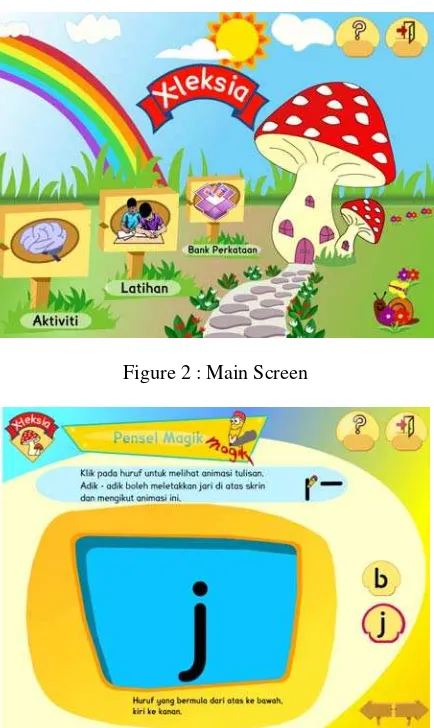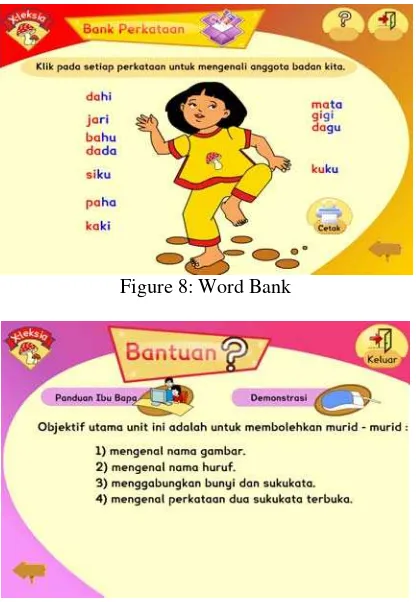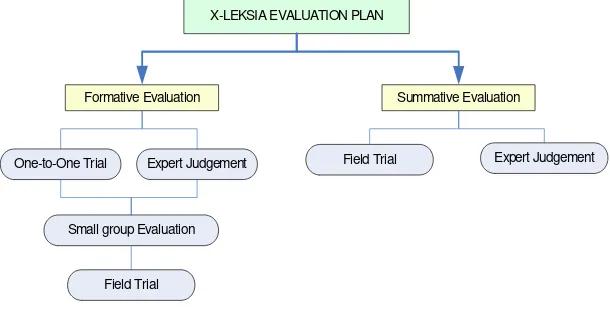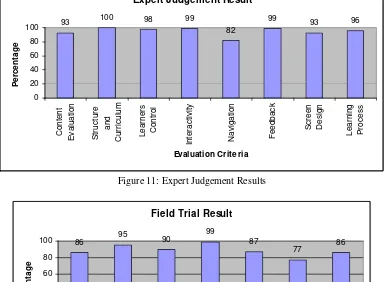E-Learning for Disability: Creation, Assessment, and Implementation
Anusuriya Devaraju, Umawathy Techanamurthy, Zeratul Izzah Mohd. Yusoh, Mohd Hafiz Zakaria Faculty of Information and Communications Technology,
Universiti Teknikal Malaysia Melaka (UTeM), Malaysia.
anusuriya@utem.edu.my, uma_leogal@yahoo.com, zeratul@utem.edu.my, hafiz@utem.edu.my
Abstract: This paper presents the design and delivery of X-Leksia: a multimedia courseware to aid basic reading skills in Malay language among the pre-school dyslexics. The courseware has been developed based on multi-sensory teaching approach. It supports the visual, auditory, kinaesthetic elements via multimedia and “learn by doing” exercises that will reinforce each other for optimal learning. The courseware has undergone both formative and summative evaluation with dyslexics and subject matter experts from Dyslexia Association of Wilayah Persekutuan, Kuala Lumpur. The evaluation procedure, criteria and results are presented in this paper. As a result of completing the evaluation procedure, the author found that X-Leksia’s approach was well received by the children and teachers alike although there is still room for improvement. The courseware is hoped to contribute a significant idea to the development of technology in Malay language education for pre-school dyslexics in Malaysia.
Introduction
Interactive multimedia occurs when the user can control ‘what’, ‘when’ and ‘how’ elements such as text, audio, video, graphics and animations are presented. It has the capacity to deliver
learning materials in multiple forms which can motivate learners with specific learning difficulties. Dyslexia is most commonly characterized by difficulties with learning how to decode at the word level, to spell, and to read accurately and fluently. Dyslexic individuals often have difficulty ‘breaking the code’ of sound-letter association, and they may also reverse or transpose letters when writing or confuse letters such as b, d, p, q, especially in childhood. In Malaysia, it should be noted that dyslexia is a condition that affects more than 300,000 or 10 percent of schoolchildren, in both primary and secondary schools (Dyslexia Association of Singapore, 2004). This number is alarming and an early intervention is vital. Despite being a lifelong condition; most dyslexics learn to read and write well through appropriate training. The paper presents the design, development and implementation of an assistive multimedia
courseware, named X-Leksia, to aid the basic reading in Malay language among pre-school dyslexics.
The Motivation
The motivation to come up with X-Leksia is due to the weaknesses in the current traditional teaching practice which has been addressed by the Subject Matter Expert (SME), from Dyslexia Association of Wilayah Persekutuan, Kuala Lumpur. The traditional teaching method is via passive prints and illustrations do not attract the dyslexics’ attention. Moreover, the learner needs someone’s guidance to follow the lessons. In general, the common teaching method used in Malaysian schools when handling dyslexics is using the reading skills used by their non-dyslexic counterparts. Furthermore, there is lack of educational software in the market that teaches
Teaching Principles for Reading Disability
The following teaching principles formed the basis for designing the methodology for our study.
Multi-sensory Teaching. “Studies from the National Institutes of Child Health and Human Development have shown that for children with difficulties learning to read, a multi-sensory teaching method is the most effective approach or treatment” (Bradford, 2000). This teaching employs all pathways of learning at the same time, seeing, hearing, touching, writing and speaking. It helps to develop links between what a word looks like, sounds like and means.
Orton-Gillingham. The Orton-Gillingham approach is language-based, multi-sensory,
structured, sequential, cumulative, cognitive, and flexible. The approach teaches how sounds and letters are related and how they act in words. Reading and writing sounds are done in isolation in the beginning. Next, sounds are blended into syllables and words. Dyslexics will learn language elements, e.g., consonants, vowels, digraphs, blends, and diphthongs, in an orderly fashion. They then proceed to advanced structural elements such as syllable types, roots, and affixes (Academy of Orton – Gillingham, 2004). Language Tune-Up Kit (The Language Tune-Up Kit, 2006) and Phonics Tutor (PhonicsTutor Classic CD-ROM, 2005) are learning packages that have been developed based on this approach.
Design, Development and Implementation
The courseware’s structure, material design and development will be covered in the following section.The learning materials included in the courseware are from a book series (Amirin, 1990), which is currently used as main teaching materials at Dyslexia Association of Kuala Lumpur (DAKL).
User Interface Design Guidelines
The materials design and development guidelines set out in this courseware are based on
Bradford (2000),Rainger (2003) and Pickard (2005) whom have outlined principles of usability and accessibility of electronic educational content for dyslexics. Details explanation on user interface guidelines followed in the courseware development can be found here (Zakaria et al., 2006).
Courseware Structure
hearing and touch. Self test exercises are included at the end of courseware to assess the child’s progress.
Figure 1: X-Leksia Courseware Structure
i. Main Screen
Figure 2 shows the welcoming page with the navigation buttons linking to the other major learning modules such as Activities, Exercises, Word Bank and Help. Voice over for the navigation buttons and instructions are provided. All the learning components have a link back to the main screen.
ii. Activity
Activity module provides foundations of reading and writing. It has two modules which are Bacaan Bergambar (Picture-based Reading) and Pensel Magik (Magic Pencil).
Magic Pencil module as shown in Figure 3 guides the dyslexics on how to read and write letters using 2D animation. Letters have been categorized into four different categories according to the way a letter can be written i.e. from the right, from the left, from top to bottom, left to right and from the middle. Dyslexics follow the 2D animation on screen by placing their fingers on screen. Here, the visual, audio and kinaesthetic elements used will reinforce each other for optimal learning. This involves a creative, participatory act by dyslexics.
Figure 2 : Main Screen
The Picture-based Reading module as in Figure 4 module involves vision and hearing senses which can be used in learning. Here, the learner will first figure out the story content from the pictures. This is an example of exploratory driven based learning. The learner will make the transition to learn the syllables that make up the word. Each word contains two syllables represented in two standard colours used in the Dyslexia Association. The dyslexic learner will then watch a simple animation of the syllables appearing as it is pronounced by the voiceover. Once the learner understands the material, words become more meaningful.
iii. Exercises
The Exercises functions as ‘learn by doing’ module to apply or test the knowledge learnt in the previous Activity module. It includes varied and interesting games-based learning, for example, Dengar dan Seret (Listen and Drag), Jigsaw Puzzle and Dengar dan Eja (Listen and Spell). All the instructions will be read out and hints will be available on each exercise, each one providing more details about the answer to a question. A positive, animation-based feedback will be displayed when the user completes each exercise. This type of positive feedback can stimulate learner interest and can be regarded as a form of encouragement for learners who pass a task, creating a sense of achievement.
The Jigsaw Puzzle module (Figure 5) requires dyslexics to complete a jigsaw puzzle which consists of an image and its word. The Listen and Drag exercise (Figure 6) requires dyslexics to listen to the pronunciation of different words and match it with the correct picture. In Listen and Spell exercise (Figure 7), dyslexics will listen to each word and pick the correct letters from an onscreen ‘qwerty’ keyboard to spell the word. A unique feature here is the keys on the onscreen keyboard has been already categorised according to the four ways letters are written in the Magic Pencil module using four different colours.
Figure 4: Picture-based Reading
Figure 5. Jigsaw Puzzle
Figure 6: Listen and Drag
iv. Word Bank
Word Bank module (Figure 8) is designed to increase the dyslexics’ vocabulary. Here, dyslexics will learn more four lettered – two syllables words from the chosen category, for example parts of the body. According to the SME, dyslexics learn words better when they are categorized. In addition, there will be a printable worksheet available in this module.
Figure 8: Word Bank
v. Help tool
The help tool has a step by step ‘video’ demonstration on how to use each screen. It also contains the learning objectives of each module be used as parental guide. In particular, this is also unique from other text based help modules found in other e-learning tools.
Figure 9: Video-based help tool
Courseware Evaluation
The courseware evaluation consists of both formative and summative evaluation which had been customized from the Dick and Carey model (Dick et al., 2001). The purpose of formative evaluation is to provide data for revising and improving instructional materials and conducted during development stage, while the summative evaluation is conducted to study the
effectiveness of courseware as a whole after the courseware has been implemented.
Evaluation Strategy
The strategy for evaluating X-Leksia had the following goals: to report on the usability (ease of learning and ease of use) of X-Leksia and the effectiveness of X-Leksia as a teaching tool. The effectiveness of X-Leksia depends on whether the identified module achieves its learning objectives.
number of respondents involved in formative evaluation due to limited number of students available at the association when the evaluation was carried out.
The summative evaluation which was quantitative in nature, investigated the goals and the objectives of X-Leksia as a learning tool based on multi-sensory approach. It had two phases: expert judgment with the 3 subject matter experts and instructors; field trial with 15 dyslexics from DAKL.
Figure 10: Courseware Evaluation Strategy
Evaluation Guidelines
The courseware evaluation on X-Leksia’s usability is designed based on evaluation framework proposed by (Elissavet, et al., 2003), as listed in Table 1 below.
Table 1: Courseware Evaluation Guidelines
Area of Evaluation Evaluation guideline Content Correct use of grammar
Current and error-free information
Concepts and vocabulary relevant to dyslexics’ abilities Information relevant to age group curriculum
Information of sufficient scope and depth Logical progression of topics
Variety of activities
Curriculum & Structure
Can be used by dyslexics alone, without the need of other instructional objects (i.e. book) The content is structured in a clear and understandable manner
The structure of courseware permits dyslexics to advance, repeat the unit, or escape to explore another unit.
Learners Control Learner’s control corresponds to dyslexics’ age
Learner’s control corresponds to dyslexics’ cognitive capabilities
The quantity of learner’s control corresponds with the feedback given from the courseware.
Interactivity The interactivity of the courseware is according to the maturity of the students. Courseware provides opportunities for interaction at least every three or four screens. The content is chunked into small segments.
Courseware asks students to apply what they have learnt in the activities rather than memorize it.
Courseware allows dyslexics to discover information through active exploration
Navigation Help key/button to get procedural information
X-LEKSIA EVALUATION PLAN
Summative Evaluation Formative Evaluation
One-to-One Trial Expert Judgement Field Trial
Small group Evaluation
Expert Judgement
Check/Submit key/button for answering a question Objective key/button for reviewing the course’s objectives.
Content page for seeing a list of options available Main Menu key for returning to the main page
Exit key/button, for exiting the program
Key/button for moving forward or backward in a lesson Key/button for accessing the next lesson in a sequence.
Feedback Courseware provides feedback immediately after a response.
Courseware provides feedback to verify the correctness of a response.
For incorrect responses, information is given to the student about how to correct their answers, or hints to try again.
Courseware allows students to print out materials.
Screen Design Screens are designed in a clear and understandable manner
The presentation of information can captivate the attention of students. The presentation of information can stimulate recall.
The design does not overload student’s memory.
The use of space is according to the principles of screen design. The design uses proper fonts in terms of style and size. The use of text follows the principles of readability The colour of the text follows the principles of readability. The number of colours in each screen is no more than six There is consistency in the functional use of colours
The quality of the text, images, graphics and animation is good The use of graphics support meaningfully the text provided A high contrast between graphics and background is retained.
There is only one moving image (animation and/or video) each time on the same screen Animations enhance the presentation of information.
Sound is of good quality and enhances the presentation of information. The integration of presentation means is well coordinated.
Courseware in general has a distinct and easily recognized character. The information is organized into small and functional units.
Each learning unit is presented under the same design principles (consistency).
Learning process Courseware is easy to learn Courseware is efficient to use
Courseware is easy to remember; the casual user is able to return to using it after some period without having to learn everything all over.
The structure of courseware is comprehensive and the average performance dyslexics can easily follow it.
Users do not make many errors during the use of courseware or if they do so they can easily recover them.
Users are subjectively satisfied by using courseware. Users find courseware interesting.
Result and Analysis
received by the respondents.However, the Listen and Spell module received slightly poor response because the screen was a bit cramped and the module considered as very challenging for the learners.
Both graphs showed that the feedback to X-Leksia is encouraging. However, the results were rated based on a small number of the respondents. Therefore, courseware evaluation involving adequate number of respondents will be conducted in future with dyslexics and subject matter experts from other Dyslexia associations and schools that offer remedial classes.
Expert Judgement Result
Figure 11: Expert Judgement Results
Field Trial Result
Figure 12: Field Trial Results
Conclusion and Future Works
Overall, there are a number of future works that might be pursued. The first suggestion by parents and teachers was to add a video showing how to pronounce each word used in the
the mouth, facial expressions and gestures. Next, an animated character may be designed to be the narrator in the courseware instead of just using the narrator’s voice for voice over to retain the interest of the learners. In addition, the authors plans to develop own fonts to overcome some irregularities produced by the Lexia Readable font used throughout X-Leksia. More interesting, game-based activities and exercises will be added into the courseware.
To sum up, the biggest contribution of this project towards the education of dyslexia is the implementation of the multi-sensory teaching approach while adhering to general design
guidelines for educating dyslexics via interactive multimedia technology. The courseware helps dyslexics to enrich their learning experience, and it has given them better control of their
learning pace which is self motivating. X-Leksia is an early intervention product to complement other teaching aids to help students with the highest risk of reading failure and early enough to prevent it. The courseware is hoped to contribute a significant idea to the development of technology in Malay language education for dyslexics in Malaysia.
Acknowledgments
The author would like to thank Madam Sariah Amirin, the President of Dyslexia Association of Wilayah
Persekutuan, Kuala Lumpur for her guidance and experience sharing as the Subject Matter Expert throughout the courseware development.
References
[1] Academy of Orton – Gillingham (2004) ‘What is the Orton Gillingham approach?’ Available from URL : http://www.ortonacademy.org/approach.html.
[2] Amirin, S., (1990) ‘Mari Mengenal Abjad’, Kuala Lumpur, Berita Publications. [3] Bradford., J., (2005) ‘Using multisensory teaching methods’. Available from
URL: http://www.dyslexia-parent.com/mag30.html
[4] Bright Solutions for Dyslexia (1998) ‘The Orton Gillingham Multisensory Method’. Available from URL: http://www.dys-add.com/teach.html#ogmethod
[5] Dick, W. and Carey, L. (2001). ‘The Systematic design of instruction’ (5th edition), New York, Addison-Wesley Educational Publishers.
[6] Dyslexia Association of Singapore (2004), ‘Pilot programme for dyslexics in Malaysia’. Available from URL :
http://www.das.org.sg/news/malaysiapilotprogramme.htm
[7] Elissavet, G. and Economides, A.A.(2003) ‘An Evaluation Instrument for Hypermedia Courseware’,
Educational Technology & Society, 6(2), 31-44. Available from URL : http://www.ifets.info/journals/6_2/4.pdf [8] The Language Tune-Up Kit (2006). Available from URL: http://www.jwor.com/
[9] Zakaria, M.H., Technamurthy, U.,Devaraju, A., (2006) ‘Development of a Multimedia Courseware for Children with Dyslexia’, paper presented at UPSI Regional Seminar & Exhibition on Educational Research 2006, 2006, Kuala Lumpur Malaysia.
[10] PhonicsTutor Classic CD-ROM (2005). Available from URL : http://www.phonicstutor.com
[11] Pickards, J. (2005) ‘Designing for Dyslexia: How do we help’. Available from URL : http://www.thepickards.co.uk/Articles/Designing_for_Dyslexia.cfm




